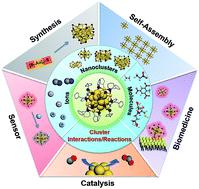当前位置:
X-MOL 学术
›
Chem. Sci.
›
论文详情
Our official English website, www.x-mol.net, welcomes your
feedback! (Note: you will need to create a separate account there.)
Molecular reactivity of thiolate-protected noble metal nanoclusters: synthesis, self-assembly, and applications
Chemical Science ( IF 7.6 ) Pub Date : 2020-11-23 , DOI: 10.1039/d0sc04620e Qiaofeng Yao 1 , Zhennan Wu 1 , Zhihe Liu 1, 2 , Yingzheng Lin 1, 2 , Xun Yuan 3 , Jianping Xie 1, 2
Chemical Science ( IF 7.6 ) Pub Date : 2020-11-23 , DOI: 10.1039/d0sc04620e Qiaofeng Yao 1 , Zhennan Wu 1 , Zhihe Liu 1, 2 , Yingzheng Lin 1, 2 , Xun Yuan 3 , Jianping Xie 1, 2
Affiliation

|
Thiolate-protected noble metal (e.g., Au and Ag) nanoclusters (NCs) are ultra-small particles with a core size of less than 3 nm. Due to the strong quantum confinement effects and diverse atomic packing modes in this ultra-small size regime, noble metal NCs exhibit numerous molecule-like optical, magnetic, and electronic properties, making them an emerging family of “metallic molecules”. Based on such molecule-like structures and properties, an individual noble metal NC behaves as a molecular entity in many chemical reactions, and exhibits structurally sensitive molecular reactivity to various ions, molecules, and other metal NCs. Although this molecular reactivity determines the application of NCs in various fields such as sensors, biomedicine, and catalysis, there is still a lack of systematic summary of the molecular interaction/reaction fundamentals of noble metal NCs at the molecular and atomic levels in the current literature. Here, we discuss the latest progress in understanding and exploiting the molecular interactions/reactions of noble metal NCs in their synthesis, self-assembly and application scenarios, based on the typical M(0)@M(I)–SR core–shell structure scheme, where M and SR are the metal atom and thiolate ligand, respectively. In particular, the continuous development of synthesis and characterization techniques has enabled noble metal NCs to be produced with molecular purity and atomically precise structural resolution. Such molecular purity and atomically precise structure, coupled with the great help of theoretical calculations, have revealed the active sites in various structural hierarchies of noble metal NCs (e.g., M(0) core, M–S interface, and SR ligand) for their molecular interactions/reactions. The anatomy of such molecular interactions/reactions of noble metal NCs in synthesis, self-assembly, and applications (e.g., sensors, biomedicine, and catalysis) constitutes another center of our discussion. The basis and practicality of the molecular interactions/reactions of noble metal NCs exemplified in this Review may increase the acceptance of metal NCs in various fields.
中文翻译:

硫醇盐保护的贵金属纳米团簇的分子反应性:合成、自组装和应用
硫醇盐保护的贵金属(例如Au和Ag)纳米团簇(NC)是核心尺寸小于3 nm的超小颗粒。由于这种超小尺寸范围内强大的量子限域效应和多样的原子堆积模式,贵金属NC表现出许多类似分子的光学、磁性和电子特性,使其成为新兴的“金属分子”家族。基于这种类似分子的结构和性质,单个贵金属NC在许多化学反应中表现为分子实体,并对各种离子、分子和其他金属NC表现出结构敏感的分子反应性。尽管这种分子反应性决定了NCs在传感器、生物医学、催化等各个领域的应用,但目前文献中仍缺乏对贵金属NCs在分子和原子水平上的分子相互作用/反应基础的系统总结。 。在这里,我们基于典型的M(0)@M( I )–SR核壳结构,讨论了理解和利用贵金属NCs在合成、自组装和应用场景中分子相互作用/反应的最新进展方案,其中M和SR分别是金属原子和硫醇盐配体。特别是,合成和表征技术的不断发展使得贵金属NC能够生产出具有分子纯度和原子级精确结构分辨率的贵金属NC。这种分子纯度和原子精确的结构,加上理论计算的巨大帮助,揭示了贵金属NCs的各种结构层次(例如M(0)核、M-S界面和SR配体)中的活性位点分子相互作用/反应。 贵金属NC在合成、自组装和应用(例如传感器、生物医学和催化)中的分子相互作用/反应的剖析构成了我们讨论的另一个中心。本综述中举例说明的贵金属NC分子相互作用/反应的基础和实用性可能会提高金属NC在各个领域的接受度。
更新日期:2020-11-23
中文翻译:

硫醇盐保护的贵金属纳米团簇的分子反应性:合成、自组装和应用
硫醇盐保护的贵金属(例如Au和Ag)纳米团簇(NC)是核心尺寸小于3 nm的超小颗粒。由于这种超小尺寸范围内强大的量子限域效应和多样的原子堆积模式,贵金属NC表现出许多类似分子的光学、磁性和电子特性,使其成为新兴的“金属分子”家族。基于这种类似分子的结构和性质,单个贵金属NC在许多化学反应中表现为分子实体,并对各种离子、分子和其他金属NC表现出结构敏感的分子反应性。尽管这种分子反应性决定了NCs在传感器、生物医学、催化等各个领域的应用,但目前文献中仍缺乏对贵金属NCs在分子和原子水平上的分子相互作用/反应基础的系统总结。 。在这里,我们基于典型的M(0)@M( I )–SR核壳结构,讨论了理解和利用贵金属NCs在合成、自组装和应用场景中分子相互作用/反应的最新进展方案,其中M和SR分别是金属原子和硫醇盐配体。特别是,合成和表征技术的不断发展使得贵金属NC能够生产出具有分子纯度和原子级精确结构分辨率的贵金属NC。这种分子纯度和原子精确的结构,加上理论计算的巨大帮助,揭示了贵金属NCs的各种结构层次(例如M(0)核、M-S界面和SR配体)中的活性位点分子相互作用/反应。 贵金属NC在合成、自组装和应用(例如传感器、生物医学和催化)中的分子相互作用/反应的剖析构成了我们讨论的另一个中心。本综述中举例说明的贵金属NC分子相互作用/反应的基础和实用性可能会提高金属NC在各个领域的接受度。









































 京公网安备 11010802027423号
京公网安备 11010802027423号